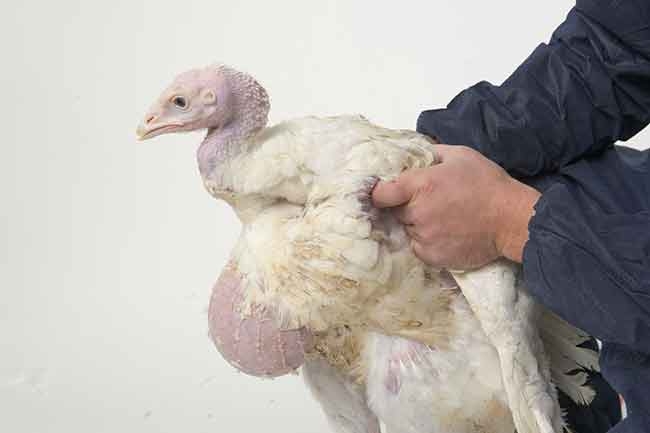
Feed Efficiency in Turkeys
By Lilian Schaer on behalf of the Livestock Research Innovation Corporation (LRIC) for the Poultry Industry Council
Features New Technology Production Poultry Research ResearchResearch shows a genetic link between pendulous crop and how turkeys convert feed
 Correlations between pendulous crop and feed efficiency traits show that pendulous crop should be included in the selection index whenever a feed efficiency trait is also included Photo courtesy of the Poultry Industry Council
Correlations between pendulous crop and feed efficiency traits show that pendulous crop should be included in the selection index whenever a feed efficiency trait is also included Photo courtesy of the Poultry Industry Council
New data analysis has shown there is a genetic link between pendulous crop in turkeys and how well the birds convert feed. This means certain birds may be more predisposed towards developing pendulous crops given their nutrition, management, environments, or combination of these.
This type of correlation is not uncommon in genetics when breeding for certain traits, and geneticists work hard to find balance between desired traits and resulting effects in other areas.
A pendulous crop is a pouch that hangs down lower than it should in poultry and becomes filled with feed and water that the bird can’t digest. Birds suffering from this condition will slow their growth and in some instances can become emaciated.
“Our research was aimed at determining what, if any, genetic relationship there might be between feed efficiency and pendulous crop in turkey, and if there was, whether we might be able to correct for this in a breeding program,” says Owen Willems of Hybrid Turkeys – the company behind the research.
“Avoiding pendulous crops in the turkey population is important to having an economically successful flock, as there is no recovery from this affliction,” he adds.
Researchers at Hybrid Turkeys examined eight years of data from their Ontario-based turkey breeding program in both a sire and dam line to come to their conclusions.
They discovered a small genetic relationship between pendulous crops and feed efficiency in the sire line, which over time, could cause a slight increase in occurrence of pendulous crop as the feed conversion ratios are improved through the breeding program.
In the dam line, however, there was no link, which shows that feed efficiency can be improved through that avenue without increasing the risk of pendulous crop.
Researchers concluded that the correlations between pendulous crop and feed efficiency traits show that pendulous crop should be included in the selection index whenever a feed efficiency trait is also included.
“Given the results of this work at Hybrid, we now have a clearer idea moving forward on how to decrease the incidence of pendulous crop in turkeys through genetic selection,” Willems says.
Pendulous crop is largely a seasonal problem, occurring particularly during hot weather, and is attributed to over-drinking and over-feeding or gorging.
To minimize the risk of birds developing pendulous crop, producers should:
- Make sure birds have access to clean, cool water at all times
- Sanitize drinkers regularly and monitor chlorine levels in the water
- Monitor water consumption to determine if turkeys are drinking more or less water than usual
- Maintain regular, consistent access to feed
- Ensure poults don’t become overheated. During brooding, room temperatures should be 29-33C
Visit www.hybridturkeys.com for additional information.
“Prevention is key here as there is no economically viable treatment available for pendulous crop,” Willems advises.
The research was funded by Hybrid Turkeys (a Hendrix Genetics company), the Poultry Industry Council, and the University of Guelph. More information is available from Ben Wood at ben.wood@hendrix-genetics.com, or from the full abstract at https://asas.org/docs/default-source/wcgalp-proceedings-oral/120_paper_3657_manuscript_86_0.pdf?sfvrsn=2.
Print this page